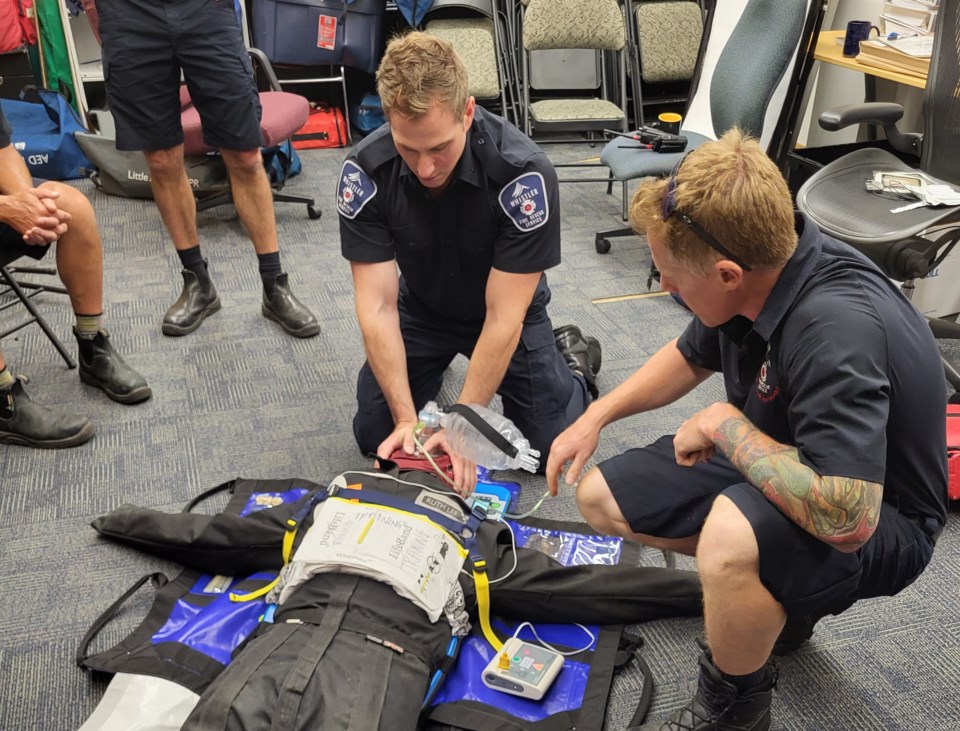A new CPR device was barely out of the box when Whistler firefighters used it to save a patient’s life last week.
The incident occurred when career staff from the Whistler Fire Rescue Service’s (WFRS) Village Gate station responded to reports of an individual in cardiac arrest last Thursday, July 20, shortly before 9:30 a.m.
Luckily for that patient, WFRS had put its new ZOLL AutoPulse CPR device into service earlier that morning. Firefighters had just completed training on the device during their shift the day before.
“The crew starts at eight o’clock [a.m.] here, and they were just getting the truck checks completed when a call came in at 9:22 for a cardiac arrest,” explained WFRS chief Thomas Doherty in a video call. “That was one of the crews that had just been trained, so they grabbed the device and threw it in the truck and responded to the call.”
The device was recently purchased with the help of just over $53,700 granted to the Whistler Professional Firefighters Association this spring by the Whistler Blackcomb Foundation, supplemented by an additional $10,000 from the Whistler Health Care Foundation. The equipment arrived at the Whistler Fire Station “a couple of weeks ago,” Doherty said.
The AutoPulse Resuscitation System is designed specifically for patients suffering from cardiac arrest. The automated machine provides continuous, consistent compressions, even if first responders are transporting the individual down stairwells, around sharp corners, or in cramped elevators where crews would typically need to pause traditional chest compressions. “This particular device uses a distributing band that goes around the chest, so when it does a compression, it actually compresses the whole chest cavity as opposed to the typical over-the-sternum pressure,” Doherty explained.
“The profusion rates are way higher with this device compared to standard methods of chest compressions,” he added, or about 33 per cent.
These are “all key pieces to giving the patient the best possible chance of a positive outcome,” Doherty noted.
According to data Doherty has seen, use of the AutoPulse device during a cardiac arrest response resulted in an 85-per-cent drop in chest-compression interruptions, and a higher rate of cardiac patients who survive to be discharged from the hospital.
When firefighters arrived at the scene last Thursday, outside of a residence in the 4600 block of Blackcomb Way in the Upper Village, bystanders were already performing CPR on the patient. The WFRS crew deployed the AutoPulse device in addition to its Automated External Defibrillator. “Through their efforts, they regained a pulse back,” said Doherty. The patient was transferred to the Whistler Health Care Centre for further treatment.
It’s “pretty amazing that we had it in service for just over an hour and we saved a life,” Doherty added in an email.
The AutoPulse device is intended to help Whistler’s firefighters “fill the gap in pre-hospital care,” the Whistler Blackcomb Foundation said in a release last month.
If it wasn’t already clear, the WFRS’ scope extends far beyond just fighting fires. The department is part of a layered first-responder program that typically sees BC Ambulance Service dispatchers task WFRS with responding to the most serious medical calls that occur within the resort. Doherty estimated about 400 to 500 of the approximately 1,300 calls WFRS crews respond to each year are for medical emergencies.
In most of those cases, firefighters are first to arrive on-scene. “We have stations throughout the community, but there’s just one ambulance station here on Lorimer,” Doherty explained. “In this particular call, we did arrive on-scene first, and started the protocol before ambulance arrived, but it’s a combined effort. It takes a lot of resources when you’re dealing with somebody in cardiac arrest.”
Community grants like the ones that paid for the AutoPulse are “extremely important” to the municipally-funded WFRS, Doherty said. The device was “something we probably weren’t going to be able to purchase this year. We put requests in through the [Resort Municipality of Whistler] budget process, but there’s a lot of pressure on the financial budget and taxation, so we want to be very careful with that,” he explained.
“When we’ve got community groups like this that are providing funding opportunities, we want to make sure we take a good look at those and use those for valuable assets that will really provide a benefit to the community.”
The successful cardiac response wasn’t the only highlight for Whistler firefighters on Thursday. According to Doherty, firefighters responded to a call at about 7:20 p.m. that same day to help a patient who was reportedly choking at a local restaurant.
“When they arrived at that call, the patient was in cardiac arrest as well,” Doherty said. “Through the work with the team there and BC Ambulance on-site, they resuscitated that patient as well. So that was a good day for us where we had two lives saved.”
Is two cardiac arrest calls in a single day out of the ordinary for the WFRS crew?
“Sometimes when it rains it pours,” Doherty said.
“It is good for the crew to know that they put their best foot forward and to get a positive outcome like that. It’s pretty uplifting for them.”




